10 Essential Features of Construction Job Costing Software

10 Essential Features of Construction Job Costing Software
Overview
This article provides an overview of the essential features of construction job costing software, emphasizing their significance in enhancing financial management and project efficiency. Key functionalities include:
- Real-time data tracking
- Integration with accounting tools
- Automated reporting
- Enhanced budgeting capabilities
These features are crucial for improving cost management, decision-making, and overall profitability in construction projects.
Real-time data tracking allows project managers to monitor expenses as they occur, providing immediate insights into financial performance. Integration with accounting tools streamlines processes, reducing the risk of errors and ensuring that financial data is accurate and up-to-date. Automated reporting saves time and resources, enabling teams to focus on analysis rather than data entry. Enhanced budgeting capabilities empower organizations to allocate resources more effectively, leading to better financial outcomes.
Incorporating these features not only improves operational efficiency but also fosters a culture of informed decision-making. How might implementing such software transform your project management approach? By leveraging these advanced tools, construction firms can position themselves for success in a competitive industry.
Introduction
Construction firms today encounter significant challenges in managing costs, ensuring compliance, and maximizing profitability. The right construction job costing software can serve as a transformative tool, offering essential features that streamline operations and enhance financial accuracy. Yet, with a plethora of options available, how can companies discern which tools provide genuine value? This article explores ten critical features of construction job costing software that not only improve budgeting and reporting but also empower firms to navigate the complexities of their projects with confidence.
Initial Data Offering: Access High-Quality Datasets for Accurate Job Costing
The Initial Data Offering (IDO) serves as a vital resource for construction firms in need of high-quality datasets essential for accurate project budgeting when using construction job costing software. This platform grants access to , labor rates, and material prices—elements crucial for developing precise estimates. By leveraging IDO's comprehensive datasets, companies can enhance their construction job costing software to align with current market conditions, resulting in more competitive bids and increased profitability.
For example, by utilizing alternative data on material expenses, contractors can adjust their budgets in real-time. This ensures they stay within financial limits while improving project outcomes. Such a proactive approach to data utilization can have a significant impact on construction profitability. Accurate historical cost data within construction job costing software enables better forecasting and risk management. In fact, research indicates that inadequate cost estimation is a leading cause of budget overruns, contributing to industry losses exceeding $1.84 trillion. Therefore, by integrating reliable historical data into their estimating processes, construction firms can mitigate these risks and enhance their overall financial performance.
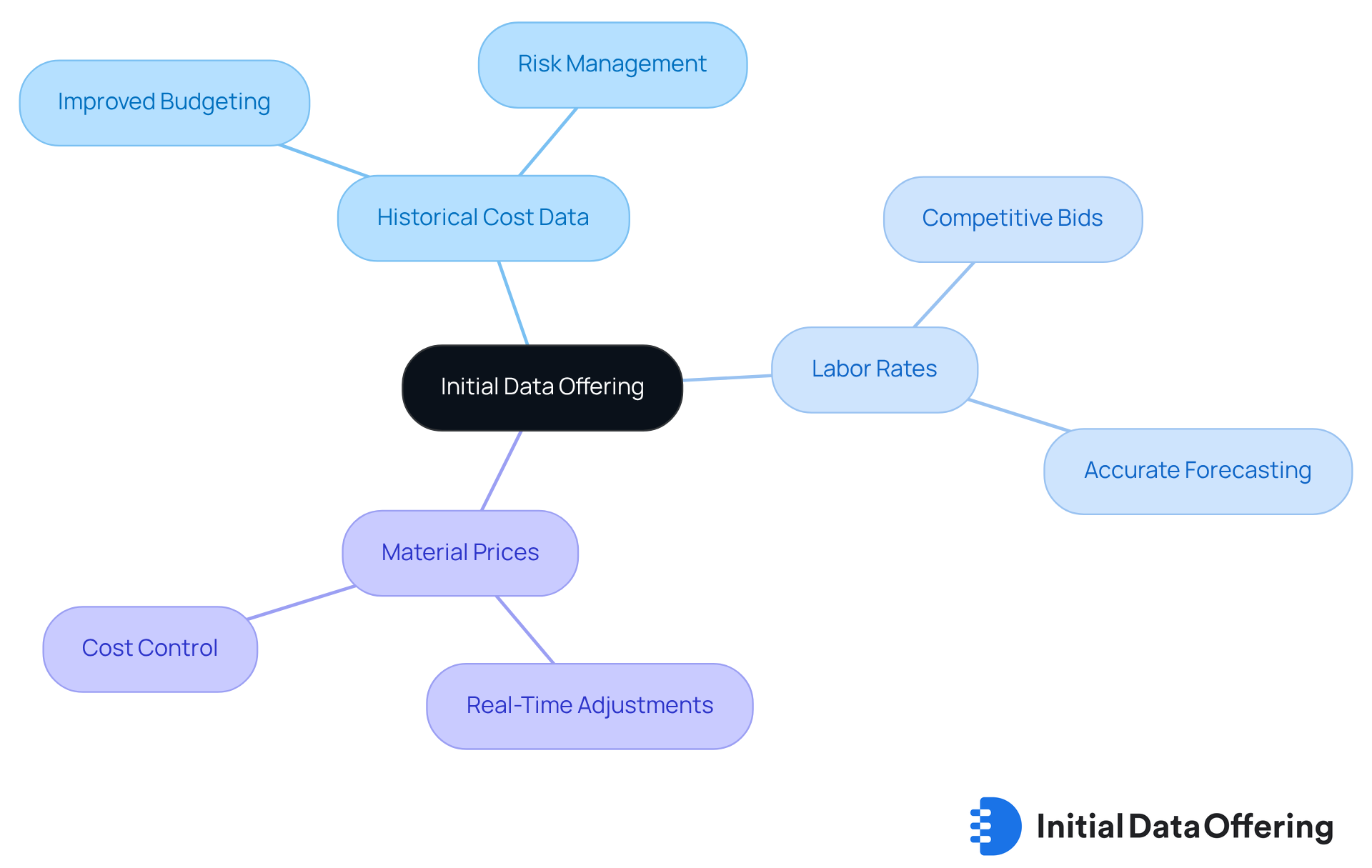
Real-Time Data Tracking: Improve Cost Management and Decision-Making
Real-time data tracking empowers construction companies to monitor costs as they occur, delivering immediate insights into budget adherence. By integrating construction job costing software with real-time tracking features, managers can swiftly recognize discrepancies between estimated and actual costs. This timely awareness facilitates quick adjustments, significantly .
For instance, when labor expenses exceed forecasts, managers can promptly redistribute resources or adjust schedules to mitigate financial impacts. This proactive approach not only enhances overall management efficiency but also fosters a culture of accountability and transparency. Notably, 61% of contractors utilizing real-time management tools reported improved schedule adherence, illustrating the tangible benefits of this integration. Furthermore, Dodge Data & Analytics indicates that 75% of construction sector stakeholders agree that managers need greater autonomy for rapid decision-making, underscoring the importance of real-time data in promoting accountability.
Moreover, firms such as RG Construction Services, Inc. have showcased the effectiveness of real-time tracking, saving up to 20 hours a week through streamlined operations. Such efficiencies highlight the critical role of construction job costing software in facilitating real-time cost monitoring, which drives informed decision-making and optimizes outcomes. However, the construction sector currently faces challenges, including ongoing labor shortages and difficulties in filling management roles, which emphasize the necessity for efficient data management solutions.
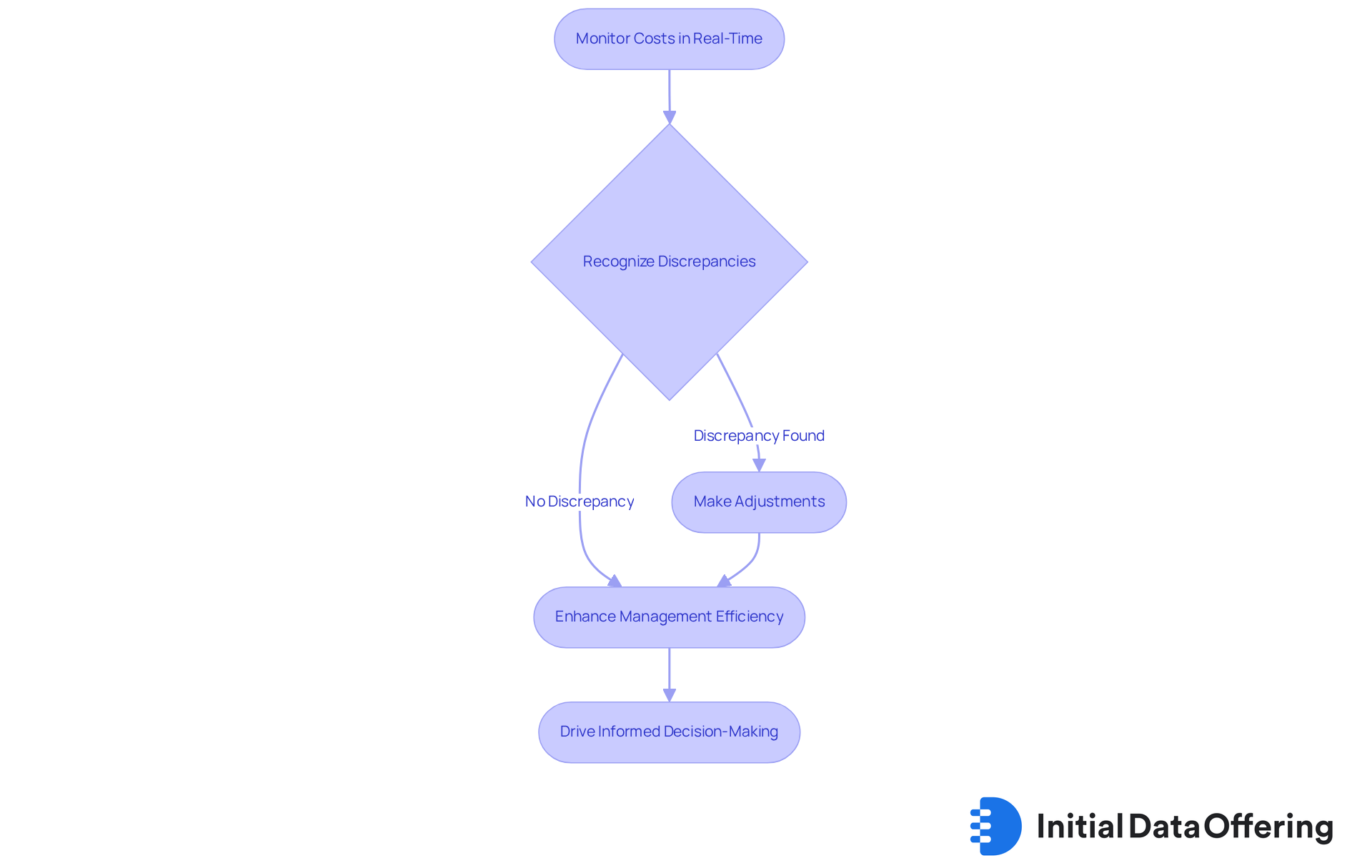
Integration with Accounting Tools: Streamline Financial Processes
Incorporating construction job costing software with current accounting tools significantly enhances financial procedures by automating data transfers and reducing manual entry mistakes. This of construction job costing software ensures that all financial data remains consistent and up-to-date, which is crucial for accurate reporting and analysis.
For instance, when job expense data is automatically synchronized with construction job costing software, managers can generate real-time financial reports that accurately reflect the current status of assignments. The implementation of construction job costing software not only saves time but also enhances the accuracy of financial forecasts, enabling more effective strategic planning. As Eric Fortenberry points out, 'Having real-time data through job accounting helps contractors prevent profit losses by allowing prompt corrective measures.' Moreover, construction job costing software enables automated invoicing, ensuring that every billable item is documented directly from task data, further enhancing the efficiency advantages of automation in financial procedures.
Furthermore, effective job estimation through construction job costing software can enhance profitability analysis by identifying high-performing projects, making it essential in the construction sector where timely and accurate financial insights can significantly influence project outcomes. As the industry develops, 62% concur that current accountancy training programs will be inadequate for a successful practice by 2030, highlighting the pressing need for automation in job analysis. How can your organization leverage these advancements to improve financial accuracy and decision-making?
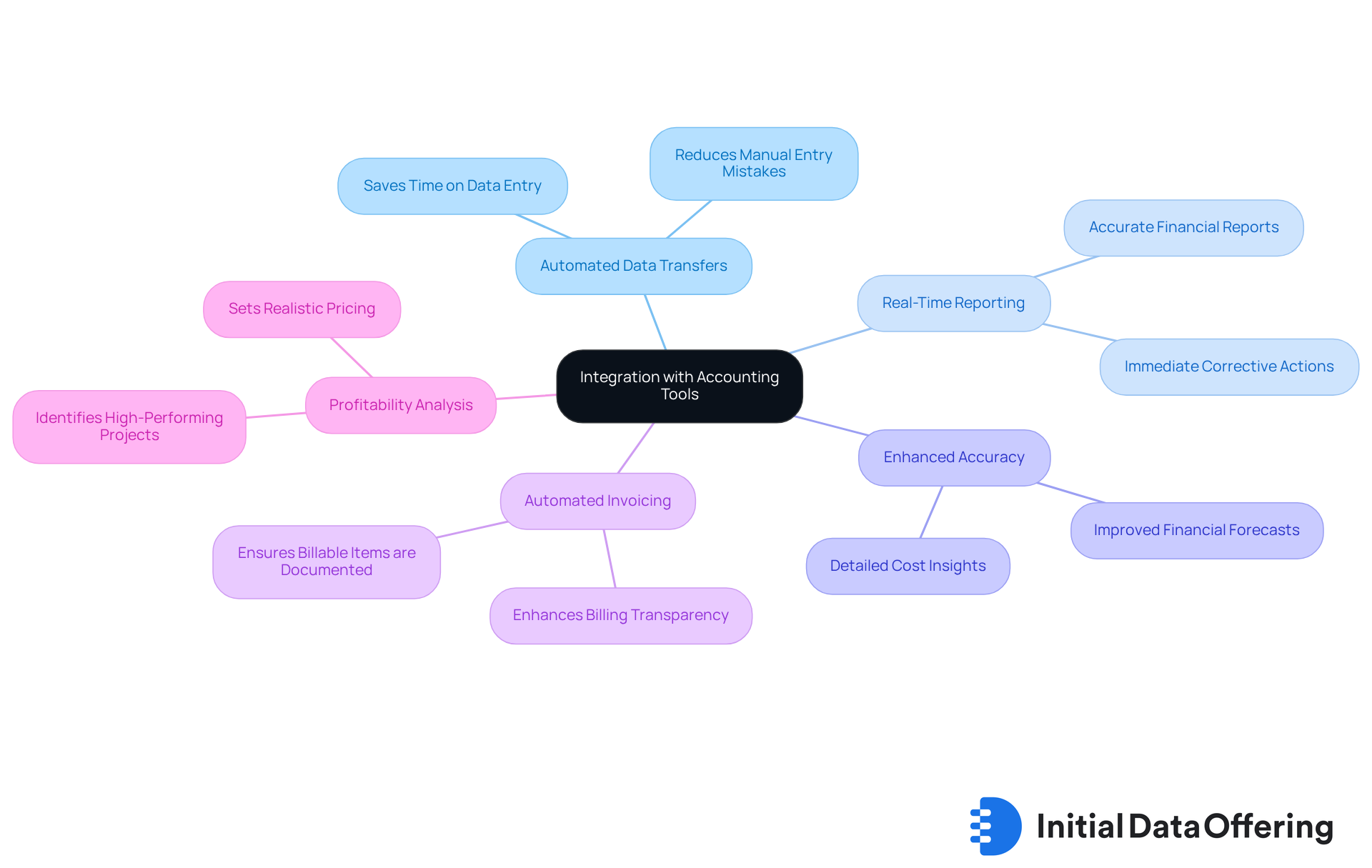
Automated Reporting: Enhance Accuracy and Save Time
Automated reporting features in construction job costing software empower construction companies to generate comprehensive financial reports with minimal manual effort. This capability conserves valuable time and significantly boosts the accuracy of the data presented.
For instance, automated reports can quickly provide insights into labor costs, material expenses, and overall profitability of initiatives. This enables managers to focus on strategic decision-making rather than dedicating hours to data compilation. Moreover, built-in forecasting tools can calculate forecasted costs to complete with minimal manual input, further enhancing financial accuracy.
Real-time cost monitoring is another essential aspect, as it assists in recognizing overruns promptly and modifying budgets during the process. This improves and financial supervision across initiatives. Furthermore, automated systems aid in tracking lien waivers and certificates of insurance, ensuring compliance and proper documentation, which is crucial for construction firms.
By utilizing construction job costing software, construction companies can enhance the precision of their financial reporting, ultimately aiding improved management and profitability.
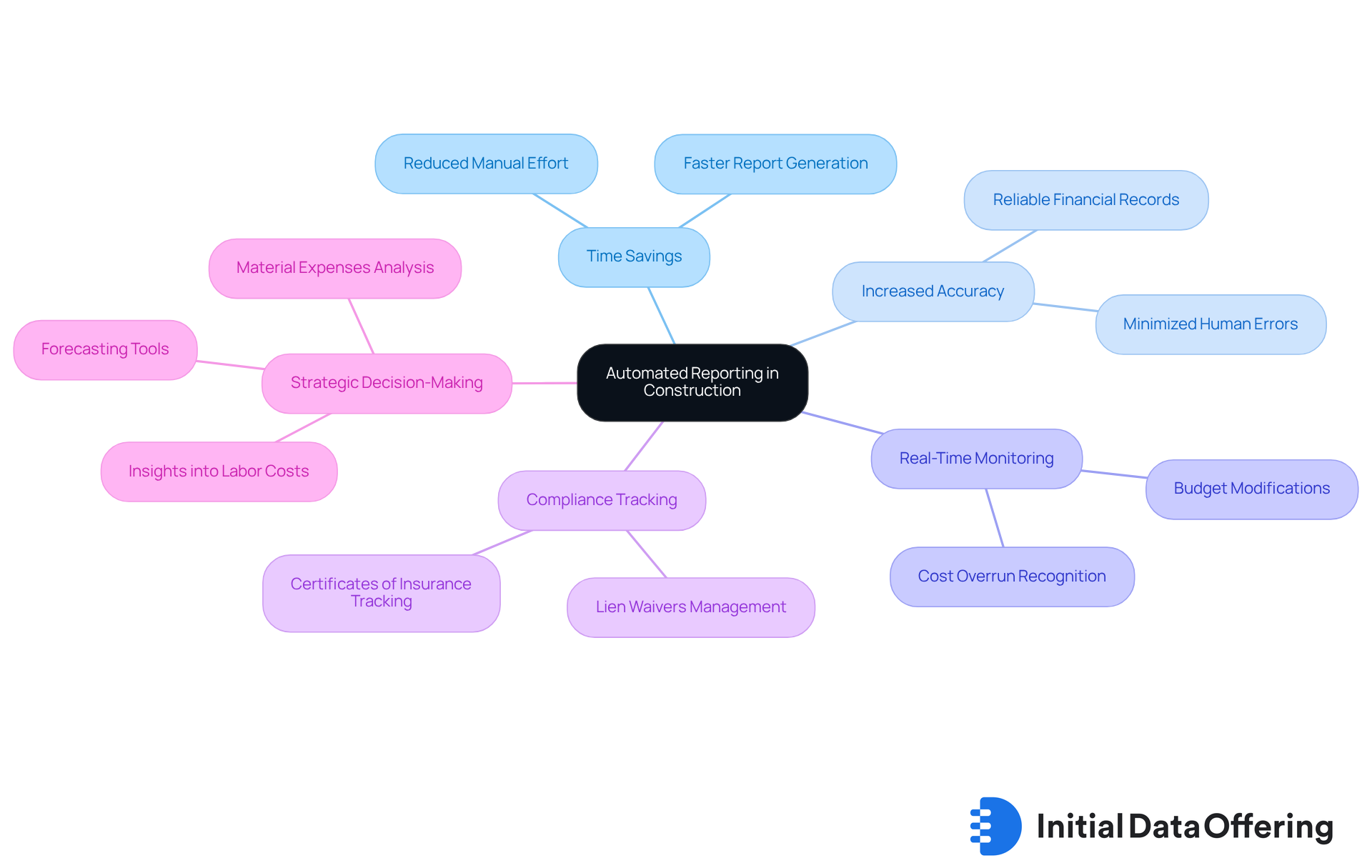
Enhanced Budgeting: Maintain Profitability Through Accurate Estimates
Enhanced budgeting capabilities in job costing software empower construction firms to generate precise estimates by utilizing historical data and real-time insights. This feature allows firms to analyze previous expenditures alongside current market trends, leading to budgets that align with realistic financial expectations. For instance, with an anticipated 9% increase in material expenses due to tariffs, contractors can proactively adjust their estimates to avoid underbidding on projects. Such an advantage not only safeguards profitability but also enables firms to effectively .
Precise evaluations, based on historical information, are crucial for preserving financial wellbeing and ensuring successful outcomes. Consistently tracking and revising estimates throughout the project lifecycle is essential for maintaining budget precision and relevance. Additionally, reviewing and validating cost estimates ensures their reliability, further supporting effective budgeting practices.
How can your firm leverage these insights to enhance your budgeting strategies and ensure project success?
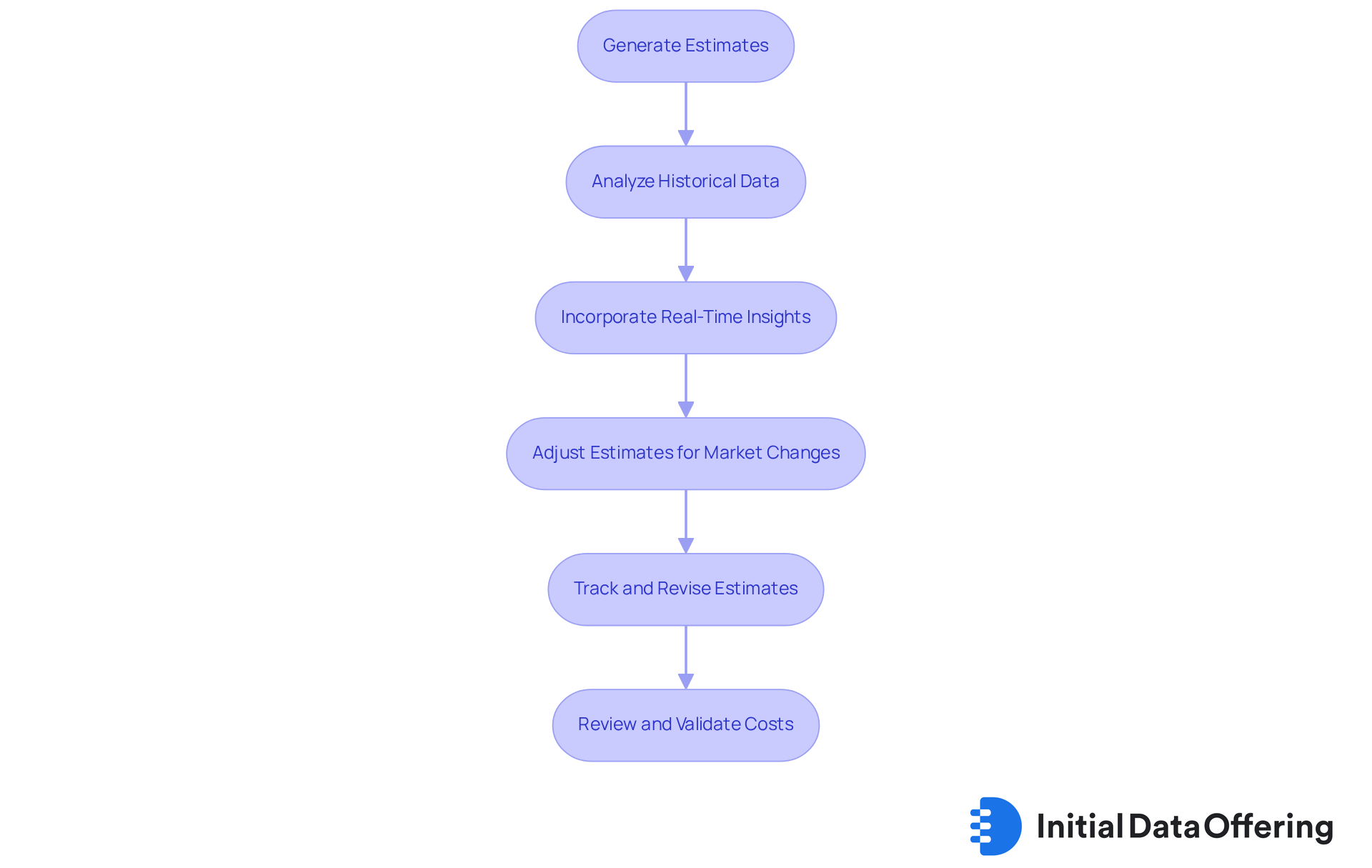
Detailed Cost Insights: Facilitate Better Financial Planning
Job tracking tools provide detailed expense insights that assist construction firms in examining their spending habits and identifying areas for improvement when using construction job costing software. By categorizing costs—such as labor, materials, and overhead—companies can utilize construction job costing software to recognize where overspending occurs and make necessary adjustments.
For instance, if a project consistently exceeds labor budgets, management can explore the reasons behind these overages and implement strategies to enhance efficiency. This level of analysis not only facilitates better financial planning but also supports effective resource allocation through construction job costing software.
How can these insights transform your financial management? Understanding spending patterns allows for more , ultimately leading to improved profitability and project success.
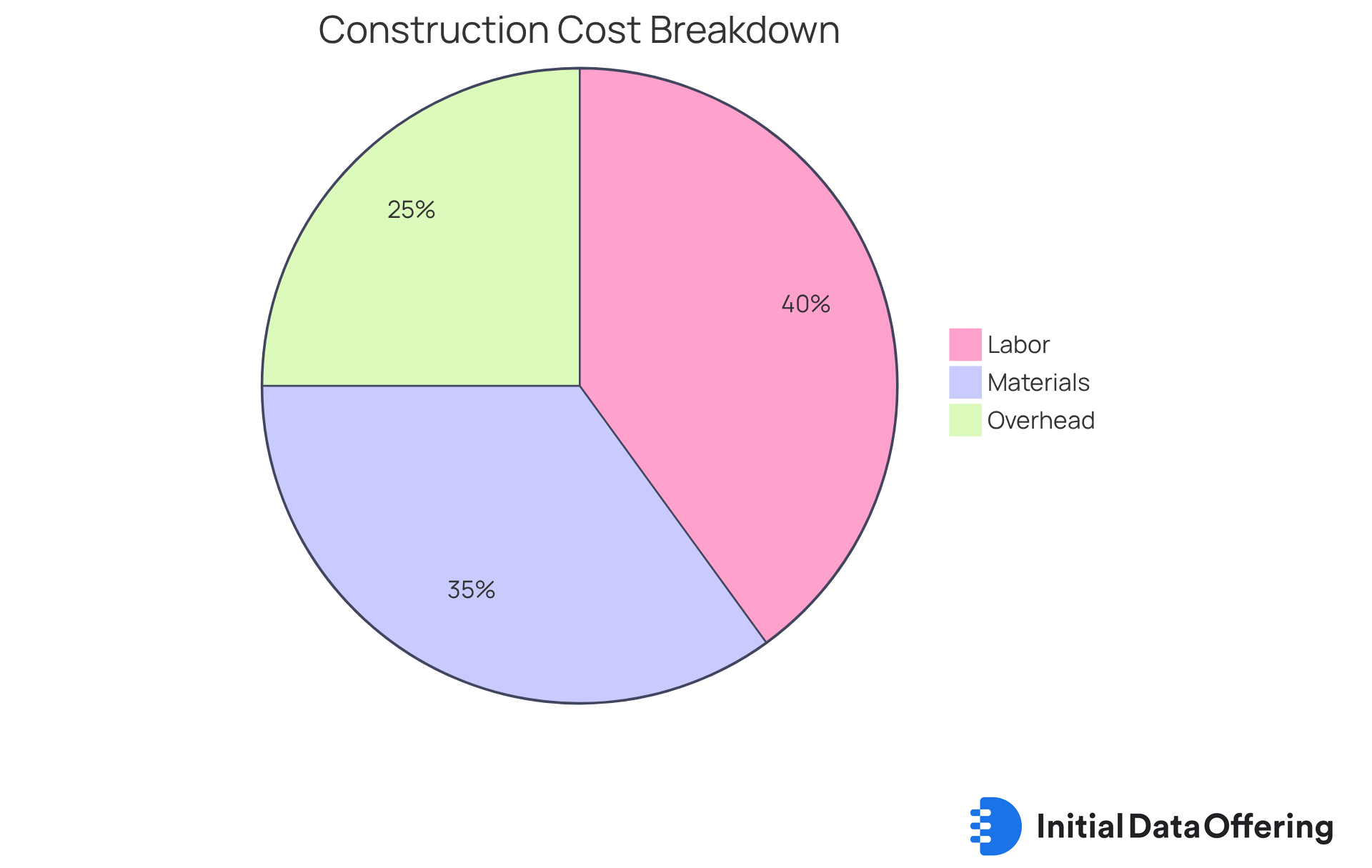
Collaboration Tools: Improve Team Communication and Efficiency
Collaboration tools integrated into construction job costing software significantly enhance communication among task teams, ensuring alignment and clarity throughout the construction process. These tools offer real-time updates and facilitate smooth information sharing, which are essential for managing the complexities of construction projects.
For instance, team members can quickly share updates regarding progress, budget adjustments, and resource availability. This immediacy minimizes the risk of miscommunication and errors, fostering a more cohesive working environment. Research from the National University of Singapore reveals that effective collaboration can improve task efficiency by up to 30%. This statistic underscores the these tools provide.
Moreover, initiatives that implement strong collaboration methods are 33% more likely to be completed on schedule and 15% more likely to stay within budget, as reported by McKinsey & Company. By streamlining communication, construction job costing software and job management tools not only enhance workflow but also contribute to overall task success, making them indispensable resources in the construction sector. Additionally, the integration of Building Information Modeling (BIM) and cloud-based management tools can further bolster collaboration and communication, ensuring that all stakeholders remain informed and engaged throughout the project lifecycle. While technology is vital, maintaining face-to-face interactions is equally important for effective collaboration, striking a balance between digital tools and personal engagement.
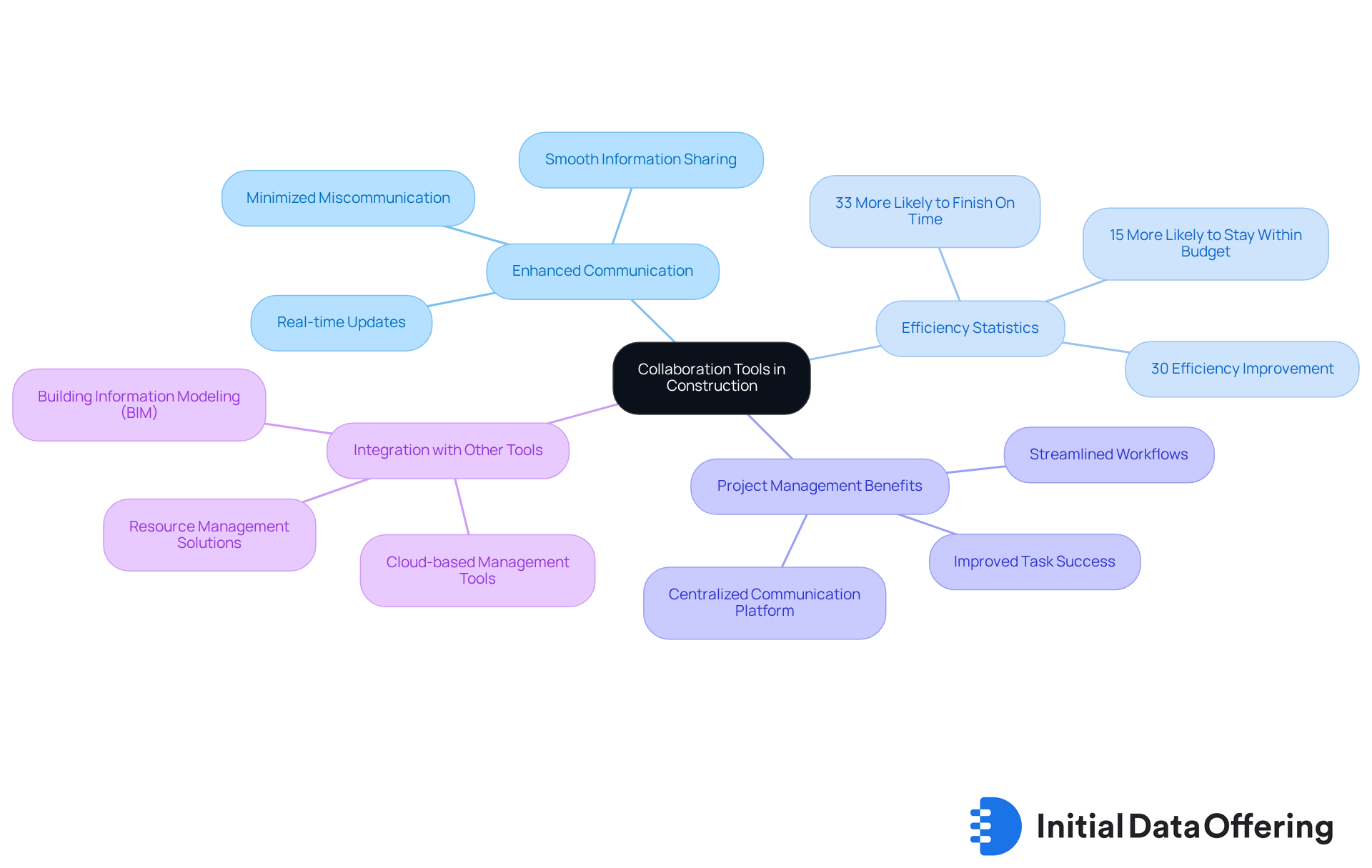
Scalability: Adapt Job Costing Solutions to Your Business Size
Scalability in construction job costing software is essential for construction firms that seek to adapt their solutions as they expand. Whether operating as a small contractor or a large construction company, scalable applications can proficiently manage varying tasks and complexities. For instance, as a company undertakes larger projects, it can seamlessly enhance its technological capabilities to accommodate increased data volume and more sophisticated reporting requirements. This adaptability not only boosts operational efficiency but also reduces the necessity for frequent software changes, allowing businesses to concentrate on delivering quality results.
Companies that implement construction job costing software frequently report improved project profitability, with technology-driven methods achieving gains of 5-15%. As Ember Davis points out, "When job analysis is treated as a proactive financial tool, it gives companies the confidence to take on larger projects, negotiate better with carriers, and invest in growth." Furthermore, she emphasizes, "Accurate job costing is the foundation for achieving those goals," underscoring the vital role of precise cost tracking in fulfilling business objectives.
Key Benefits of Scalable Job Costing Software:
- Enhanced Efficiency: Streamlined processes diminish the need for frequent software changes.
- Improved Profitability: Technology-driven approaches, such as construction job costing software, can yield gains of 5-15%.
- Adaptability: Construction job costing software allows you to easily enhance capabilities to manage larger tasks and increased data volume.
A notable instance of effective scalability is the integration of Xcelerate with Xactimate, which enables restoration companies to minimize clerical errors and monitor costs in real-time. This example illustrates the and scalable technology on project management within the construction sector.
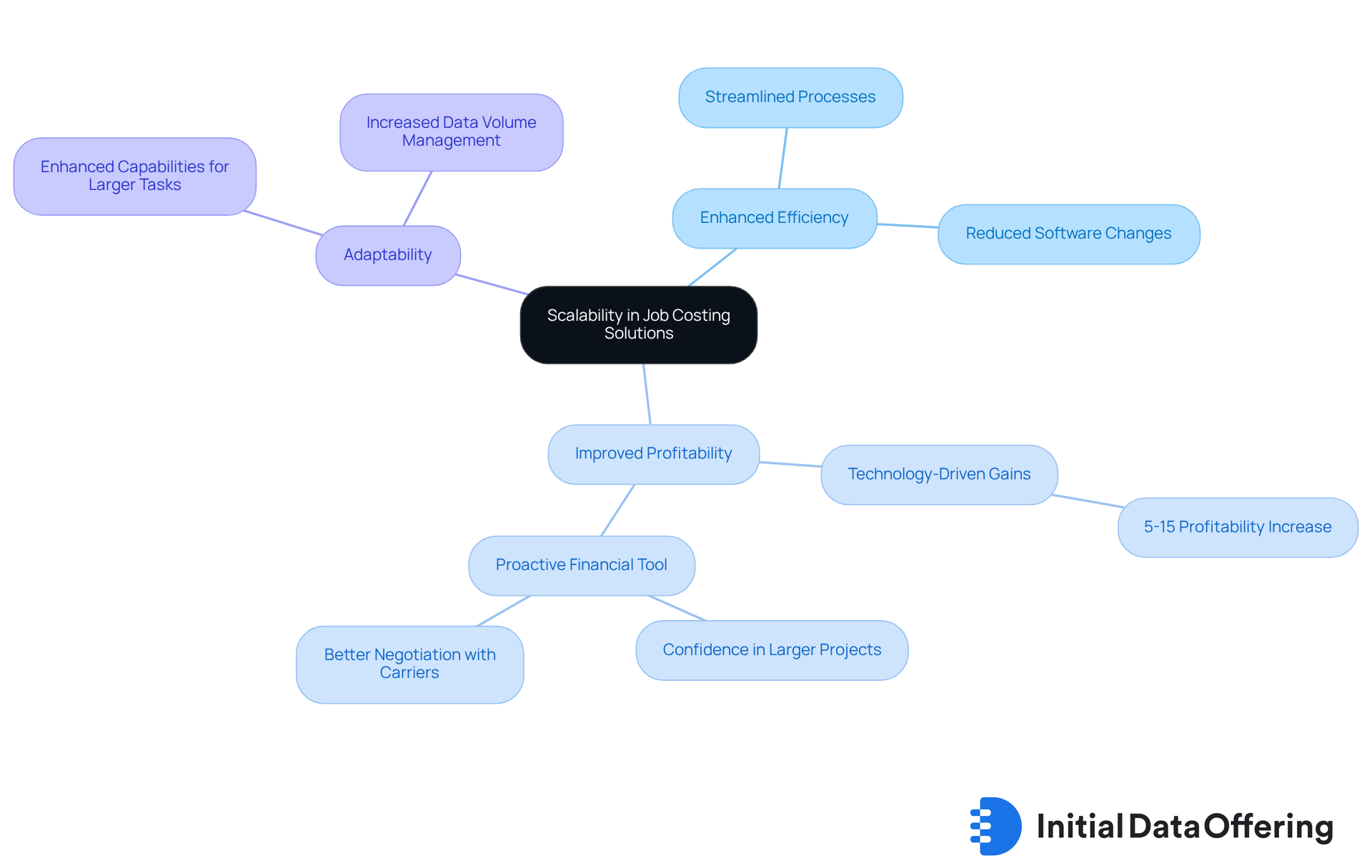
Compliance Features: Ensure Adherence to Industry Regulations
Job tracking tools frequently incorporate compliance functionalities that assist construction firms in adhering to industry regulations and standards. These features automate the tracking of compliance-related tasks, ensuring that all necessary documentation is maintained and easily accessible.
For instance, compliance tools manage labor laws, safety regulations, and environmental standards, significantly reducing the risk of legal issues and penalties. By ensuring adherence to regulations, companies not only protect themselves from potential fines but also maintain their reputation and operational integrity.
How can these compliance tools enhance your firm's operations? By streamlining compliance processes, construction firms can focus more on their core activities while ensuring they meet all necessary legal requirements. This proactive approach not only but also fosters a culture of safety and responsibility within the organization.
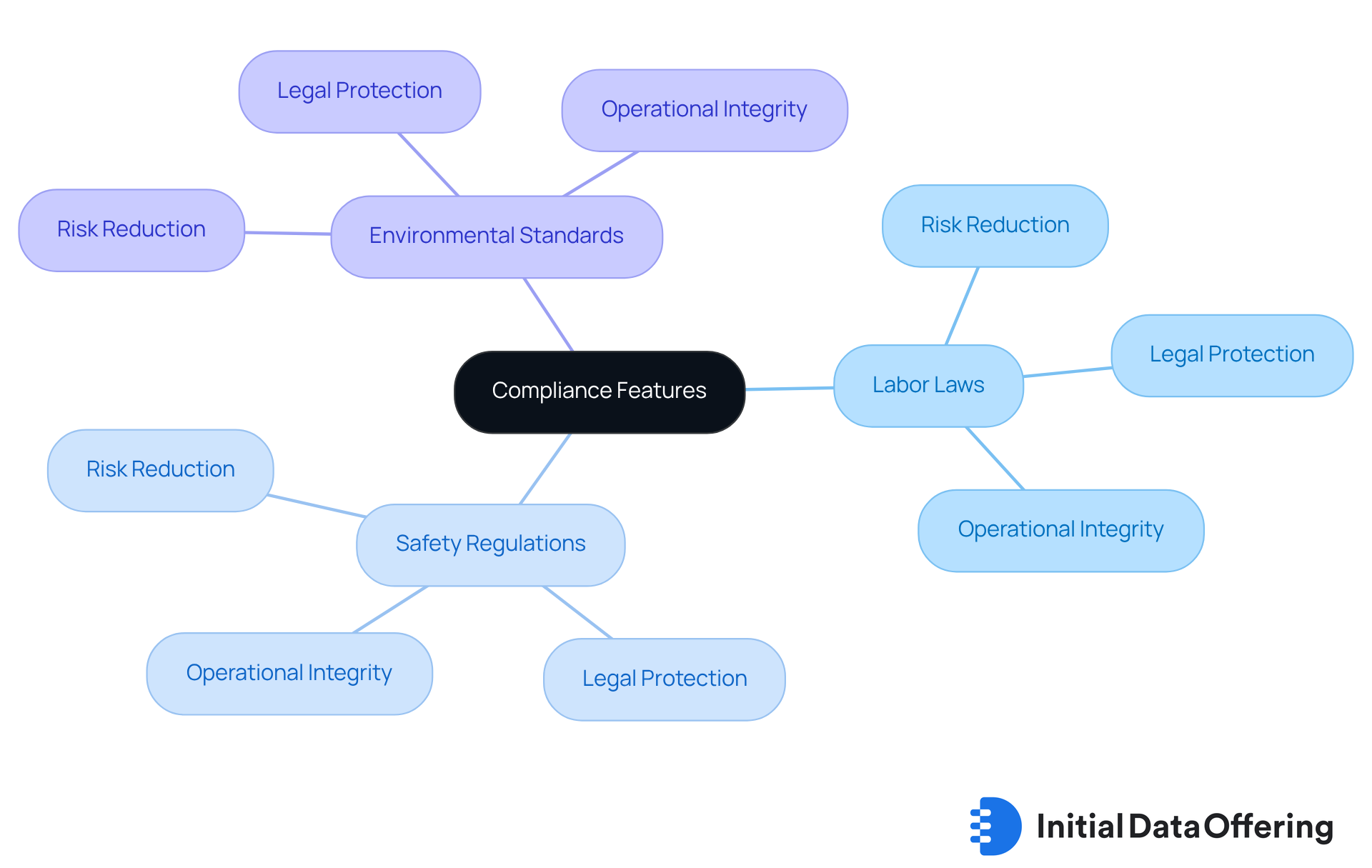
Training and Support: Maximize the Benefits of Job Costing Software
Effective training and support are crucial for maximizing the advantages of job costing tools in the construction sector. Organizations that invest in thorough training initiatives enable their teams to fully leverage application features, resulting in improved productivity and project results. For instance, organizations that prioritize continuous support allow users to resolve problems, learn new features, and remain updated about application enhancements. As ClickLearn mentions, "With applications regularly updating, it’s advisable to have periodic training sessions to keep employees informed," emphasizing the need for ongoing training in adjusting to program changes. This not only boosts employee confidence but also fosters a culture of continuous improvement.
Construction companies that have effectively established strong training programs indicate substantial improvements in technology usage. For example, studies show that employees trained through gamification are 48% more likely to complete courses and retain information longer than those using traditional methods, according to Vaibhav Srivastava. By ensuring that all team members are well-versed in job pricing software, firms can streamline operations, reduce errors, and ultimately improve their bottom line. Additionally, it is important to note that 35% of companies say they currently lack access to the right training content to deliver effective learning and development, highlighting a common challenge in the industry.
In summary, prioritizing effective training and support is essential for construction companies aiming to maximize the benefits of their job costing solutions, leading to improved financial outcomes and project success. Construction firms are encouraged to assess their current training programs against these insights to ensure they are equipped for success.
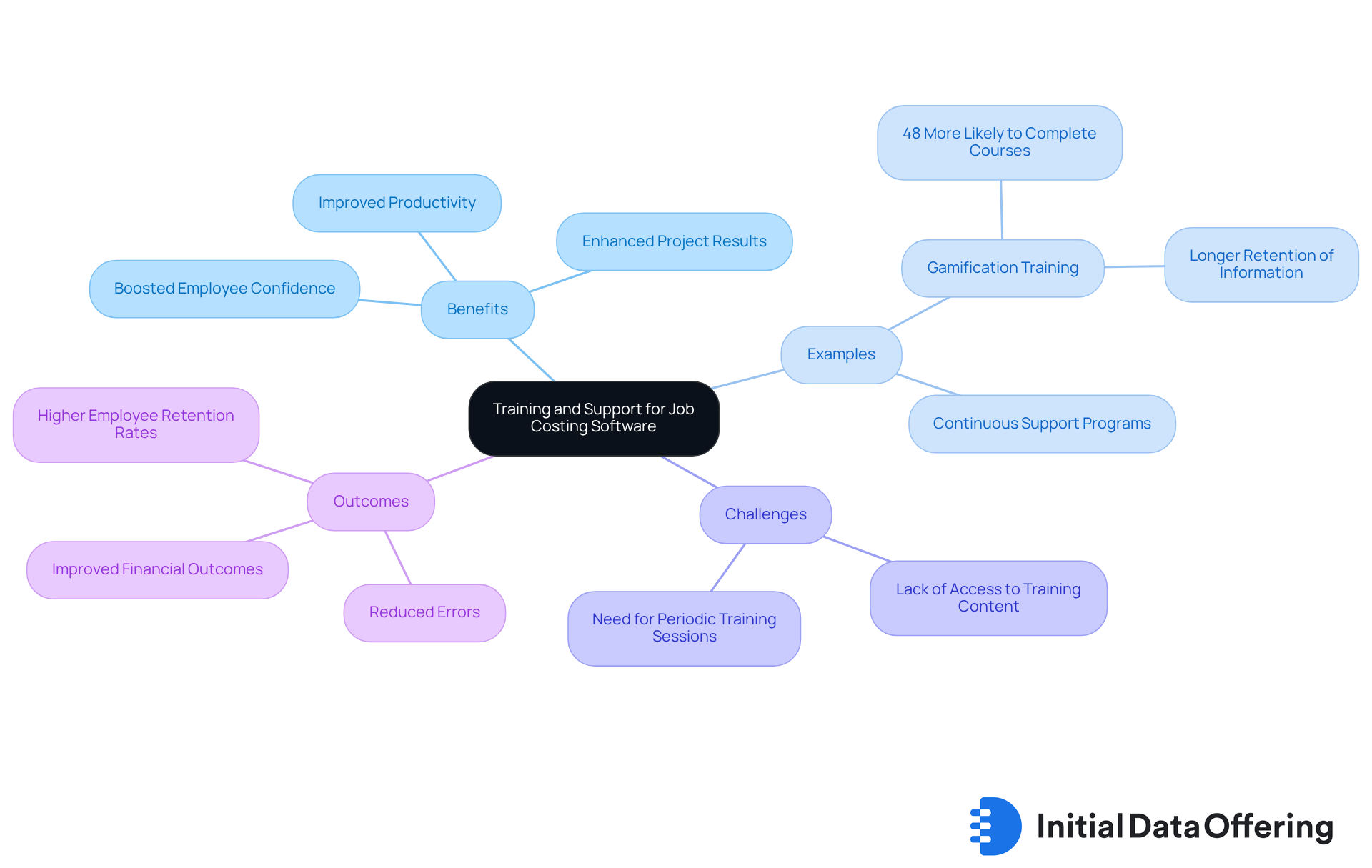
Conclusion
The integration of construction job costing software into project management practices is essential for enhancing financial accuracy and operational efficiency. By leveraging features such as real-time data tracking, automated reporting, and robust budgeting capabilities, construction firms can streamline their processes and significantly improve profitability. High-quality datasets and compliance tools underscore the importance of informed decision-making in navigating the complexities of the construction industry.
Key features like real-time data tracking, integration with accounting tools, and enhanced budgeting are critical components contributing to effective job costing. These functionalities enable construction companies to maintain better oversight of their financial health, optimize resource allocation, and ensure adherence to industry regulations. Furthermore, the scalability of job costing solutions allows firms to adapt their systems as they grow, ensuring competitiveness in a rapidly evolving market.
The advantages of utilizing construction job costing software extend beyond mere cost tracking; they foster a culture of accountability, enhance team collaboration, and promote strategic planning. As the construction industry faces challenges such as labor shortages and fluctuating material costs, investing in these technological solutions is not just beneficial but imperative for long-term success. Embracing these tools and prioritizing continuous training will empower firms to harness the full potential of job costing software, ultimately driving improved project outcomes and greater financial stability.
Frequently Asked Questions
What is the Initial Data Offering (IDO) and how does it benefit construction firms?
The Initial Data Offering (IDO) provides construction firms with access to high-quality datasets, including historical cost data, labor rates, and material prices, which are essential for accurate project budgeting using construction job costing software. This enables companies to create precise estimates, enhance competitiveness in bids, and improve profitability.
How can contractors use alternative data from IDO for budgeting?
Contractors can utilize alternative data on material expenses to adjust their budgets in real-time, ensuring they remain within financial limits while improving project outcomes. This proactive data utilization can significantly impact construction profitability.
What is the significance of accurate historical cost data in construction job costing?
Accurate historical cost data is crucial for better forecasting and risk management, as inadequate cost estimation is a leading cause of budget overruns in the construction industry. Integrating reliable historical data helps mitigate financial risks and enhances overall financial performance.
How does real-time data tracking improve cost management in construction?
Real-time data tracking allows construction companies to monitor costs as they occur, providing immediate insights into budget adherence. This enables managers to quickly identify discrepancies between estimated and actual costs, facilitating timely adjustments to reduce the risk of budget overruns.
What are the benefits of integrating construction job costing software with real-time tracking features?
Integrating real-time tracking features with construction job costing software improves management efficiency, fosters accountability, and enhances decision-making. It allows managers to promptly redistribute resources or adjust schedules when costs exceed forecasts, leading to better project outcomes.
How do construction firms benefit from the integration of job costing software with accounting tools?
Integrating construction job costing software with accounting tools automates data transfers, reduces manual entry mistakes, and ensures financial data consistency. This leads to accurate reporting, real-time financial insights, and improved strategic planning.
What role does automated invoicing play in construction job costing software?
Automated invoicing within construction job costing software ensures that all billable items are documented directly from task data, enhancing the efficiency of financial processes and preventing profit losses by allowing prompt corrective measures.
What challenges does the construction sector face regarding data management?
The construction sector currently faces challenges such as ongoing labor shortages and difficulties in filling management roles, which highlight the necessity for efficient data management solutions to improve overall operational efficiency.